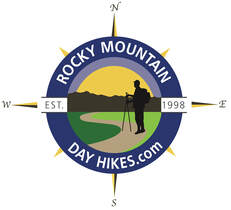|
Notes from the
Trail |
|
Adopt the pace of nature: her secret is patience. Ralph Waldo Emerson Dreaming is okay while “Staying in Place.” I am dreaming of long hikes with meadows chocked full of wildflowers, a slope of yellow avalanche lilies, and a massive clump of calypso orchids thrown in for good measure. I‘m learning patience, knowing these gifts are weeks away and that maybe my favorite spots will be inaccessible. For those who know me well, understand I have not always had a passionate relationship with Colorado native plants.
Wildflowers attract pollinators by boasting strong fragrances, bright colors, and convenient landing platforms. Bees, butterflies, flies, beetles, other insects, as well as hummingbirds come to mind. Colorado is home to 947 species of bees, most of which are native to the state. Colorado has 250 species of butterflies and over one thousand species of moths. And don’t forget eleven species of hummingbirds! Do you know how to distinguish a moth from a butterfly? Looking carefully at the antennae structure is a good start. Butterfly antennae have a ball or club shape swelling at the tips. Moth antenna lack the swelling at the tips and instead have feather-like structures along the antennas.
A few pollinators have only one host plant on which to lay eggs that hatch as caterpillars. One amazing example is the interdependence between the Soapweed Yucca, Yucca glauca, and the pronuba moth, Pronuba yuccasella, commonly called the yucca moth. Soapweed yucca is a common species of yucca along the Front Range. Pollination of soapweed yucca is dependent upon the yucca moth and the yucca moth is dependent on the plant as a food source.
The familiar yellow stonecrop (Sedum lanceolatum) is the host plant for the Rocky Mountain Parnassian Butterfly (Parnassius smintheus). Yellow stonecrop grows profusely in Hollowell Park making it a reliable place to spot the parnassian butterfly. I find the best time to photograph this butterfly is in the early cool morning hours before the butterflies are warmed by the sun.
Monarch butterflies lay their eggs on milkweed plants, no other plant. Monarch caterpillars only eat milkweeds. Monarch caterpillars have adapted to tolerate and use toxins from the milkweed as a defense from their predators—an advantageous survival skill.
It has been so satisfying for me to discover where plants grow, when they bloom, and how they are related to each other. Often a new sighting leads to more questions than answers giving me motivation to seek more time in the field. Rocky Mountain National Park offers countless free learning opportunities. Don’t let them pass you by…get out explore, observe, and learn. Marlene Borneman is the author of Rocky Mountain Wildflowers 2Ed. and The Best Front Range Wildflower Hikes, and Rocky Mountain Alpine Flowers, published by CMC Press. They can be purchased Here
0 Comments
Leave a Reply. |
"The wild requires that we learn the terrain, nod to all the plants and animals and birds, ford the streams and cross the ridges, and tell a good story when we get back home." ~ Gary Snyder
Categories
All
“Hiking -I don’t like either the word or the thing. People ought to saunter in the mountains - not hike! Do you know the origin of the word ‘saunter?’ It’s a beautiful word. Away back in the Middle Ages people used to go on pilgrimages to the Holy Land, and when people in the villages through which they passed asked where they were going, they would reply, A la sainte terre,’ ‘To the Holy Land.’ And so they became known as sainte-terre-ers or saunterers. Now these mountains are our Holy Land, and we ought to saunter through them reverently, not ‘hike’ through them.” ~ John Muir |
© Copyright 2025 Barefoot Publications, All Rights Reserved












